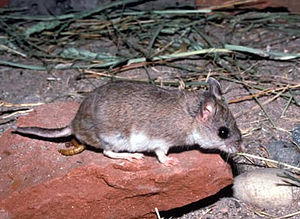Grasshopper mice
| Grasshopper mice | ||||||||||||
|---|---|---|---|---|---|---|---|---|---|---|---|---|

Onychomys arenicola |
||||||||||||
| Systematics | ||||||||||||
|
||||||||||||
| Scientific name | ||||||||||||
| Onychomys | ||||||||||||
| Baird , 1857 |
The grasshopper mice ( Onychomys ) are a species of rodent living in North America with three species from the group of New World mice . They are notable for their carnal diet.
features
Grasshopper mice reach a head body length of 9 to 13 centimeters, plus a short, 3 to 6 centimeter long tail. The weight is 30 to 60 grams. Their fur is gray-brown or red-brown on the upper side, the underside is white. The short, club-like tail is striking.
Distribution and way of life
These rodents are common in southern Canada , western regions of the United States, and northern Mexico . Their habitat are prairies and dry bush lands.
Grasshopper mice are nocturnal . They can climb well, but mostly stay on the ground. They live in nests that they build in earthworks, rock crevices or other shelters. They are territorial and react extremely aggressively to same-sex conspecifics. Then they stand up on their hind legs and emit high-frequency threat and warning calls. It is mostly the males who utter such calls. Larger animals make somewhat deeper sounds, so that the warning calls also convey information about the age and size of the warning animal.
A special feature of the species Onychomys torridus is the resistance to the toxin of the Arizona bark scorpion ( Centruroides vittatus ), one of its prey animals. These grasshopper mice have a unique glycoprotein that is activated by a component of the poison. The pain-causing effect of the poison is blocked.
nutrition
Unlike most other rodents, they are carnivores. Their prey range mainly includes insects (mainly grasshoppers and beetles ) and scorpions , but also small vertebrates (like other rodents) and even centipedes . They sneak up on their prey, take it off guard and kill it with a bite in the head.
Reproduction
Grasshopper mice can reproduce all year round, they can have several litters per year. After a gestation period of 26 to 47 days, the female gives birth to one to six young animals. The boys are weaned after two weeks and can be sexually mature at six weeks. In the wild, they rarely get older than two to three years.
The species
- Onychomys arenicola Mearns , 1896 lives in the southwest of the USA ( Arizona , New Mexico and Texas ) as well as in northeastern Mexico to Aguascalientes , San Luis Potosí and Tamaulipas . This species has a gray or red-gray coat.
- Onychomys leucogaster ( Wied-Neuwied , 1841) is distributed from southern Canada ( Alberta , Saskatchewan and Manitoba ) via the Great Plains region of the USA to northern Mexico. This species is characterized by a brownish fur and a short tail.
- Onychomys torridus ( Coues , 1874) lives in the southwest of the USA ( California , Nevada and southwest Utah ) and in northwestern Mexico ( Baja California Norte , Sonora and Sinaloa ). This species has a red-gray fur, but is larger than the similar O. arenicola .
literature
- Ronald M. Nowak: Walker's Mammals of the World. 2 volumes. 6th edition. Johns Hopkins University Press, Baltimore MD et al. 1999, ISBN 0-8018-5789-9 .
- Don E. Wilson , DeeAnn M. Reeder (Eds.): Mammal Species of the World. A taxonomic and geographic Reference. 2 volumes. 3. Edition. Johns Hopkins University Press, Baltimore MD 2005, ISBN 0-8018-8221-4 .
Web links
- Endangerment level of the individual species in the IUCN Red List of Threatened Species .
Individual evidence
- ^ Paul A. Johnsgard: Great Wildlife of the Great Plains. University Press of Kansas, Lawrence KS 2003, ISBN 0-7006-1224-6 , p. 89.
- ↑ Ashlee H. Rowe, Matthew P. Rowe: Physiological resistance of grasshopper mice (Onychomys spp.) To Arizona bark scorpion (Centruroides exilicauda) venom. In: Toxicon . Volume 52, No. 5, 2008, pp. 597-605.
- ↑ Daniel Lingenhöhl: A grasshopper mouse knows no pain Spektrum.de from January 14, 2013 (accessed on February 22, 2016)